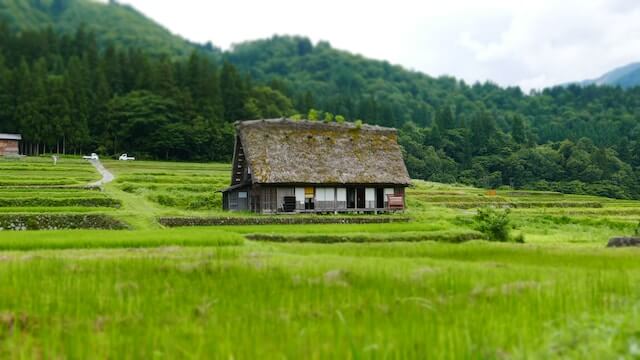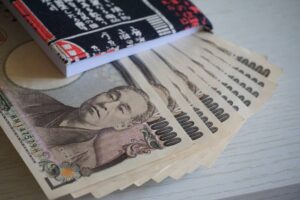Whether it’s a short or a long stay, living in Japan comes with a price tag. Fortunately, it doesn’t have to break the bank.
The cost of living in Japan is generally lower than countries in North America or Europe. Studio apartment rent can be as low as ¥30,000 ($225 USD) per month in the countryside to ¥90,000 ($670 USD) in the expensive parts of Tokyo. Non-rent related COL factors total roughly ¥160,000 ($1,200 USD) per month on average.
There’s also plenty of wiggle room in the budget for cost of living factors like utilities, transportation, clothing, food, childcare, and healthcare. This article will break it all down.
Cost of Rent in Japan
The biggest cost of living factor for most people is rent, and the closer you get to the city, the more expensive it is.
Tokyo, for example, has the highest rent in Japan, followed by other major urban centers like Osaka, Kyoto, and Fukuoka.

Photo by Daryan Shamkhali
But if you have your heart set on the capital, don’t worry. Average rent for a 1DK (dining room, kitchen, bedroom) apartment ranges from ¥59,900 ($450 USD) to ¥128,800 ($960 USD). You just need to look for the right balance between location and price.
The following table shows the average 1DK apartment rent in the low, medium, and high-cost neighborhoods of some of Japan’s most popular cities:
| City Name | Low (¥) | Medium (¥) | High (¥) |
| Tokyo | ¥59,900 | ¥74,000 | ¥128,800 |
| Kyoto | ¥40,800 | ¥50,800 | ¥60,500 |
| Osaka | ¥35,300 | ¥50,200 | ¥73,800 |
| Fukuoka | ¥29,800 | ¥36,300 | ¥46,400 |
If you’re planning on moving to the countryside, average apartment costs will usually be lower. Similar apartment sizes may be as little as ¥30,000 ($225 USD).
Urban areas can cost more in other ways, too, and you can learn more about that in our article on Tokyo’s cost of living. Compare that to areas like Kyoto or Okinawa.
Cost of Utilities in Japan
Each apartment is different, but if you’re a resident of Japan, you’re most likely paying for utilities each month. This will usually include gas, electricity, and water. On top of that, most people like to have an internet connection and cell phone plan.
Here’s simple breakdown of what you can expect to pay for utilities in Japan:
- Gas – ¥5,000 ($37 USD)
- Electricity – ¥10,000 ($75 USD)
- Water – ¥4,000 ($30 USD)
- Internet – ¥6,000 ($45 USD)
- Cell phone – ¥2,000 and up ($15 USD)
Each one of these can fluctuate based on lifestyle factors and the type of contract you choose to sign. Our per-month cost of living article goes into more detail there. You’ll also find the nitty gritty on grocery prices. Speaking of which…
Cost of Food in Japan
This part of the budget might be the hardest to shrink. You’ll be living in Japan, after all. The land of endless ramen and fresh sushi, not to mention piles of tasty sweets.
But if you do want to save money on food, it’s easily possible. If you live alone and eat in most nights, you can expect to pay around ¥50-60,000 ($375-450 USD) per month on groceries and restaurant bills.

Photo by Louis Hansel
That’s assuming that you’re not concerned at all about your budget. If you want to save even more, shop around seasonal and local fruits and vegetables, and try getting them from local farmers markets like the Japan Agricultural Cooperatives.
Restaurants are generally cheaper here, too. If you want to eat out in Japan, here’s what you can expect to pay:
- Multi-course izakaya dinner with drinks – ¥4-5,000 ($30-37 USD)
- Coco’s pork cutlet curry – ¥928 ($7 USD)
- Yoshinoya beef bowl – ¥500 ($3.75 USD)
- Most bowls of ramen – ¥750 ($5.60 USD)
- Conveyor belt sushi – ¥2-3,000 ($15-22 USD)
- Bento dinner/lunch – ¥500 ($3.75 USD)
Cost of Transportation in Japan
Trains, scooters, cars, buses… Japan has it all in spades. And each one comes with different fees.
The Japanese train system is the cheapest option by far, and it’s also convenient with the spread of prepaid IC cards and apps. If you only include the commute to and from work, you’ll pay ¥5-600 ($3.75-4.50 USD) per day for travel within the same city. Companies and organizations also typically reimburse these costs.
If you plan on owning a scooter or car, things get a little more complicated, and it’s one area that tends to bring the average cost of living in Japan up. The Tokyo COL article from above goes into more detail, but here are a few things to expect:

Photo by Redd F
- Parking space fees if you live in the city
- Bi-yearly inspection fees
- Yearly vehicle tax
- Insurance
- Gas costs
Bearing those fees in mind, the cost of owning a motor vehicle falls on a scale from moped to yellow license plate cars (keijidosha) to white license plate cars (regular engine cars).
Mopeds are likely to cost around ¥10,000 ($75 USD) per month in the city, yellow license plate cars are about ¥30,00 ($225 USD), and regular cars may be as much as ¥60,000 ($450 USD) in Tokyo. This doesn’t include the initial purchasing fee or emergency maintenance.
Cost of Clothing in Japan
On the lighter side of Japan’s cost of living, there’s clothing. Since everyone has different tastes, it’s hard to nail down a number, but the important thing to note is that there are plenty of options.
From budget to luxury, here’s what you have to choose from:
- Recycle shops. Lightly worn used clothing for as low as a few hundred yen.
- Low-cost retailers. No-name stores often found in shopping complexes.
- Mid-tier brands. Think Uniqlo or GU. You can buy a full outfit for as little as ¥5,000.
- Designer labels. Hugo Boss, Chanel, Gucci… you can find the most expensive fashion labels as well as up-and-comer brands all over. But it’ll cost you.
Cost of Healthcare in Japan

Japan has universal healthcare, meaning that if you’re living and working in the country, you’re enrolled in an insurance plan. For most, this is the national insurance system.
How much you pay for Japanese national health insurance depends on your previous year’s salary as well as your location. It’s also often bundled with pension and employment insurance payments for a total of 9.15% of your salary. Your employer will typically contribute an equal amount on top of what you pay.
This insurance covers 70% of medical services such as hospital visits, dental exams, and medication until you reach 70 years of age. The other 30% comes out of your pocket. The Ministry of Health, Labour, and Welfare gives a more detailed breakdown of health insurance costs.
Recent studies have recommended an overhaul of the Japanese healthcare system in light of the aging population, but the government hasn’t made significant changes yet.
Cost of Childcare in Japan

One solution to Japan’s aging crisis that government officials are probably rooting for the most is higher birth rates in the country. In order to make that happen, they’ve targeted young families with childcare incentives. This is the last of the seven factors that affect cost of living in Japan and other countries.
As with healthcare costs, the price tag on raising a child in Japan depends on where you live. For example, Tokyo’s policy allows for free childcare for two children from age 0-2 on top of the national policy of free care from 3-5. Eligibility is based on income.
As for education, public kindergartens cost ¥165,000 ($1,230 USD) per year on average. From age 3 through high school (15 years in total), public schools average ¥5.7 million ($42,550 USD) in total vs ¥18.4 million ($137,400 USD) for private schools.
What Does It Cost to Live in Japan per Month?

Every situation is different. Some people are supporting a family, others are supporting a lavish lifestyle involving ownership of a sports car in Shibuya.
But the basic cost for single people in Japan per month comes out to roughly ¥160,000 ($1,200 USD). This includes an average rent of ¥50,000 ($380 USD) per month and all cost of living factors outside of childcare.
It’s a comfortable budget and can be reduced if you’re really looking to pinch pennies.
How Much Does It Cost to Move to Japan?
Not including the cost of a flight, a comfortable budget for moving to Japan would be roughly ¥650,000 (around $5,000 USD). This includes apartment startup costs, furniture and appliances, and a safety net for spending during your first few months.
Consider that to be an air-tight budget for hitting the ground running. As long as you’re not building a castle on top of a mountain, you should end up with some of that budget left over.
If you want more information, have a look at our detailed breakdown of moving to Japan costs.
Cost of Living in Urban vs Rural Japan
Rural areas are usually less expensive than cities in general, and the average cost of living in Japan’s countryside is no different. Rent is the biggest factor to consider, and the less populated areas of Japan usually see a drop of ¥20,000 per month ($150 USD) on smaller units. The difference is even bigger when the apartment size increases.
Living in the countryside may also be your best shot at owning a home in Japan. Renovated akiyas (empty homes) are often well under ¥30 million ($225,000 USD) and you can receive stipends from local governments to make that even cheaper. Prices like those are a pipe dream in bigger cities.

Photo by Victor Lu
On top of homes, car ownership is also less expensive because parking fees are often free with apartment rent. Taxes and registration may be lower as well.
Finally, Japan’s government has also incentivized a re-population of the countryside in recent years. For example, Tokyo families can receive ¥1 million ($7,500 USD) per family that re-locates to a small town. Each additional child earns another ¥1million.
Of course, the low countryside cost of living comes at the cost of employment and lifestyle opportunities.
Conclusion
When put up against most developed nations, the cost of living in Japan is reasonable. Food prices are low, whether you’re buying groceries or dining out, childcare is affordable, and Japan gets good grades on most of the other cost of living factors.
Its weakest areas are transportation fees (if you decide to own a car) and rent (if you live in the city).
But if you’re looking for an exciting place to live and save for the future, Japan can be a very attractive place.



